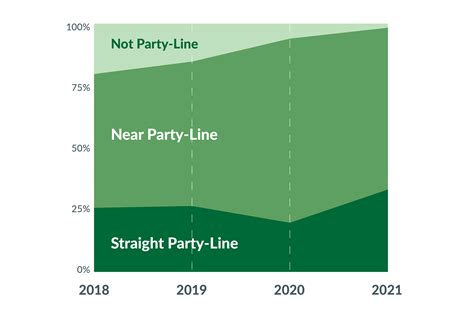What is Party-Line Voting?
Party-line voting occurs when a majority of members of a political party vote the same way on a particular issue or bill. This phenomenon is prevalent in legislatures and other governing bodies where members are affiliated with political parties.

Causes of Party-Line Voting
Several factors contribute to party-line voting in AP Gov:
1. Party Discipline
Political parties often establish rules and norms that encourage members to vote together. This discipline helps maintain party unity and presents a unified front on issues.
2. Ideological Cohesion
Party members tend to share similar ideologies and beliefs, which can lead to alignment in voting patterns. For example, Republican Party members generally support conservative policies, while Democratic Party members advocate for liberal ones.
3. Party Leadership
Party leaders, such as the party whip, can influence members’ voting behavior. They can persuade, negotiate, or even threaten to ensure party unity on critical issues.
4. Political Polarization
Political polarization, where different parties hold opposing views, can exacerbate party-line voting. When parties are ideologically distinct, they may find it challenging to find common ground on certain issues.
5. Gerrymandering
Gerrymandering, the practice of drawing electoral districts to favor one party, can create electorates that are more homogeneous in terms of political affiliation. This often results in increased party-line voting within those districts.
Consequences of Party-Line Voting
Party-line voting has several consequences:
1. Reduced Debate and Compromise
Excessive party-line voting can stifle debate and compromise. When members are unwilling to deviate from party lines, the exchange of ideas and the search for common solutions can be hindered.
2. Partisan Gridlock
Party-line voting can lead to partisan gridlock, especially in legislatures where one party controls a majority. When parties are unwilling to compromise or cooperate, passing legislation becomes difficult.
3. Weakened Public Trust
Excessive party-line voting can erode public trust in political institutions. Citizens may perceive it as a sign of partisanship and a lack of accountability.
Measuring Party-Line Voting
Party-line voting is measured using the Party Unity Score (PUS). The PUS is calculated by dividing the number of party-line votes by the total number of roll-call votes. A higher PUS indicates a greater degree of party-line voting.
Reducing Party-Line Voting
Several proposals aim to reduce party-line voting:
1. Open Primaries
Open primaries allow voters to vote for candidates from any party in the primary election, regardless of their party affiliation. This can help promote more moderate candidates.
2. Ranked-Choice Voting
Ranked-choice voting allows voters to rank candidates in order of preference. This can discourage strategic voting and encourage consensus-building.
3. Changes to Party Discipline
Reducing party discipline, such as allowing more dissenting votes, can promote diversity of opinion and encourage members to vote more independently.
Conclusion
Party-line voting is a complex phenomenon with both positive and negative effects. While it can provide party unity and ideological coherence, it can also lead to reduced debate, partisan gridlock, and weakened public trust. Understanding the causes and consequences of party-line voting is crucial for informed political discourse and civic engagement.
